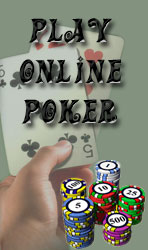Pokerwiner.com → Lessons of poker
ADVANTAGES OF THE SEMI-BLUFF
First, the semi-bluff tends to make your opponent play incorrectly according to the Fundamental Theorem of Poker.
When you semi-bluff, you presumably do not have the best hand. If your opponent could see your cards, his correct play would be to raise.
However, since you are representing something with your semi-bluff, opponents will nearly always only call. Sometimes they will make the worst play of all by folding the best hand.
Second, when the hand with which you are semi-bluffing is in fact the best hand at the moment, by betting you are not making the mistake of giving worse hands free cards.
As we saw in the previous chapter, it is critical to bet the best hand with more cards to come in order to avoid giving people a free card.
Not only will a worse hand usually fold, which is fine, especially if the opponent is getting proper odds to call, but a better hand might fold.
If the better hand calls, which is more likely, you still have the chance of improving to the best hand. If, instead of betting, you check and a better hand bets, your probably justifies a call. So you have gained nothing by checking. You do not get yourself a free card.
Hence, you are more likely to semi-bluff in first position play than in last, where you have the option of giving yourself a free card.
A third advantage of the semi-bluff is that, used correctly, it adds an enormous amount of deceptiveness to your game. For example, suppose in seven card stud you started with:
![]()


On fourth street an opponent with




Bets. You’ve caught the

Giving you Q ![]() J
J ![]() showing. This is a good spot for a semi-bluff raise even if you are almost certain your opponent will call you.
showing. This is a good spot for a semi-bluff raise even if you are almost certain your opponent will call you.
Why? Well, notice what happens when you catch certain cards on fifth street. If you catch a card such as the 9 ![]() or for that matter any card that looks as if it’s given you a straight or a flush, your opponent will very possibly fold, if not a better hand, certainly a hand that was justified in calling against a measly pair of 7s.
or for that matter any card that looks as if it’s given you a straight or a flush, your opponent will very possibly fold, if not a better hand, certainly a hand that was justified in calling against a measly pair of 7s.
Suppose you catch a jack or a queen, making a pair on board. Now your opponent almost has to fold because of the strength you showed by your earlier raise.
However, if he in fact has two kings, he is making a mistake folding against two smaller pair. Finally, notice what happens if you catch that one card that will make you root for a call, namely a 7, which gives you three-of-a-kind.
Because of your previous bet, that 7 will look completely harmless, as though it didn’t help your hand one bit.
Now when you bet, your opponent will keep coming just as you want him to. In sum, your semi-bluff raise on fourth street has made subsequent cards that help you only moderately look very dangerous, while it has made cards that give you a big hand look insignificant.
This last point is an additional benefit of the semi-bluff in stud games but especially in holdem.
When you do hit the card that makes you hand, your opponent will often misread it because of your bet on the previous round (except in the cases where you were straightforwardly betting on the come with a flush or a straight draw). Thus, you may win a larger pot than you would have otherwise expected.
Both the semi-bluff and betting a marginal had rather than risking giving a worse hand a free card are cases of the general precept that it is usually better to be betting than calling.
By betting as a semi-bluff you have a chance of winning the pot right there, something you are usually hoping to do, and you have shown greater strength than you really have.
If you catch scary-looking cards after you have been called, you are still likely to win pots you wouldn’t otherwise have won. When you bet now, your opponent is quite likely to fold.
On the other hand, when you don’t improve and are caught in a semi-bluff, that can be of value as an advertisement for the future.
A final advantage of the semi-bluff, as I suggested in the previous chapter, is that you can sometimes use it to get a free card.
Let’s say an opponent in holdem bets on the flop, and you raise with a four-flush. If that player calls haven’t made the flush, you have the option of checking behind him for a free card.



